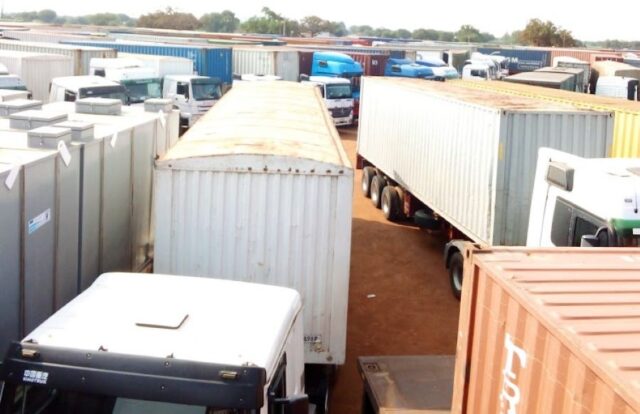
(3 Minutes Read)
Several trucks are being stuck in different yards across the country amidst delays in issuing special permits for cargo containers above 4.5 meters high by the Kenya National Highway Authority (KeNHA). KeNHA has implemented a new rule that prohibits truckers from carrying standard 40-foot-high cube shipping containers that exceed the height of 4.3 meters.
Transporters now say that delays in granting permits for special cargo containers of above 4.5 metres have affected their operations and the government risks losing business to Tanzania. Cargo services in Kenya have been badly hit by KeNHA for failing to act on cargo which has still been at the Dongo Kundu weighbridge for about eight days now. The delay has led to frustrations not only for transporters but also their client in Uganda who have been using Mombasa port for years, but increasing delays have turned out to be a nightmare.
The cargo being held at Dongo Kundu is factory assembly parts, which has resulted in a delay in the completion of the project on time. This has frustrated the promoter who is now contemplating importing his other products through the port of Dar es Salaam, said Ezekiel Mengich, logistics officer PN Mashru Ltd. Another transporter who has stayed at Mariakani for six days stated that he had applied for a special permit from KeNHA, which he had not received.
However, KeNHA maintained that only trucks that comply with the East Africa Community (EAC) Vehicle Load Act 2016 will be allowed on Kenyan roads. EAC vehicle load Act puts the maximum overall height of vehicles at 4.3 meters unless it is an abnormal load, which is allowed, subject to the authority granting an exemption permit which gives conditions on times of travel and routes to be followed, to protect public safety and road-related infrastructure, the agency said in a statement. According to the Act, the maximum overall length of vehicles should be 12.5 meters for rigid vehicles, 17.4 meters for articulated vehicles, and 22 meters for combination vehicles.
The complaints come a few months after President William Ruto ordered a multi-agency team to work on the identified NTBs to reduce the cost and time of transporting cargo along the Northern corridor. A fortnight ago, the Kenya Transporters Association (KTA) advised its more than 5,000 truck operators, and members to park/stop loading the 4.5-meter 40ft high cube shipping containers until KeNHA resolves this matter officially.
KTA has requested a 0.2-meter tolerance to allow transporters to load these containers. However, KeNHA has yet to confirm this request in writing. It is important to note that this 0.2-meter height tolerance has no negative impact on our roads or related infrastructure,” said Chairman Newton Wang’oo. It is only in Kenya that trucks carrying standard 40ft high-cube shipping containers are being impounded. Meanwhile, countries operating under the same East Africa axle load regulations, like Tanzania, are not impounding similar trucks or requiring permits for the same.
Wang’oo also asked importers to stop using the containers into Kenya and transiting through Kenya as KeNHA will impound the trucks and containers. The association wants this to be suspended until importers comply and also to apply across the region since those using the Central Corridor still enjoy the spacious containers, the KTA chairman stated further.
Read Also:
https://trendsnafrica.com/kenyas-jkia-is-the-second-largest-air-cargo-hub/
Trucks of standard dimensions loaded with standard 40ft high cube shipping containers are exceeding the prescribed height by a maximum of 0.2 meters. Most traders prefer to use the 40-foot-high cube shipping containers as they give more room to stack goods unlike general shipping units, which offer a little extra height. Each Partner State is mandated to enforce these laws within their highways under the EAC Act, of 2016 but Kenya seems to be taking the lead.











